Exploring Black Coral: Its Biology and Conservation


Intro
Black coral, often overlooked in marine discussions, is a structural marvel found deep in oceanic waters. With a unique appearance and intriguing biological attributes, it plays a pivotal role in shaping marine ecosystems. This article aims to unpack the layers of black coral, exploring not only its biological makeup but also the ecological niches it fills, and the conservation hurdles it confronts amidst increasing human intervention.
Many might not realize that black coral isn’t just a striking ornamental piece; it provides essential habitats for numerous marine species. Its ability to thrive in nutrient-poor waters highlights its remarkable adaptations, raising questions about the resilience of life in seemingly harsh environments. In doing so, we will pull back the curtain on the complex interactions taking place within marine ecosystems, illustrating how black coral contributes to biodiversity.
As we navigate this exploration, we will delve into the methods used to study these fascinating organisms, shedding light on what the latest research reveals about their biology and environment. Additionally, we will examine not just the importance of black coral to its ecosystem, but also the risks posed by activities such as climate change, pollution, and unsustainable fishing practices.
Understanding black coral is crucial—not just for marine scientists or conservationists, but for anyone interested in the health of our oceans. A deeper awareness of its role can galvanize efforts to protect it and ensure its survival for future generations. Let's begin this journey into the depths of the ocean, where the hidden world of black coral awaits.
Prelude to Black Coral
The significance of black coral in marine ecosystems cannot be overstated. This article aims to shed light on various facets of black coral, enhancing our understanding of its biology, the ecological roles it plays, and the pressing challenges it faces in conservation. By diving into these elements, the piece serves a dual purpose: to inform and to underline the urgency for protective measures. Black coral isn't just a curious organism—it’s a linchpin in the underwater web of life.
Defining Black Coral
Black coral belongs to the order Antipatharia, which includes more than two hundred species of sea life. These corals thrive in deep, dark environments, often encompassing depths of over fifty meters. Characteristic of their namesake, many black corals have a dark hue due to their unique polyp structures that contribute to their resilience and adaptability.
These corals differ markedly from the vibrant reefs commonly associated with coral. Instead of the shallow, sunlit zones, black coral flourishes in deeper waters, playing a role often overlooked in common discussions about marine ecosystems. An interesting element is that black coral skeletons can live for centuries, making them one of the oldest living organisms on Earth. Thus, understanding black coral is not just about appreciating its distinctiveness; it's about recognizing its long-term contributions to marine biodiversity.
Historical Context and Significance
The importance of black coral stretches back through history, with its presence noted in ancient artifacts and traditional practices. In some cultures, black coral was valued not only for its beauty but also for its supposed protective properties. Ancient seafarers once believed that possessing black coral would shield them from the dangers of the sea.
In the context of ecology, black coral plays a pivotal role in marine habitats. It forms complex structures that serve as habitats for various marine creatures, contributing to the rich biodiversity of deep-sea ecosystems. The interactions among species residing in these formations can be quite intricate, highlighting the interconnectedness of life beneath the waves.
Furthermore, black coral has caught the attention of researchers exploring climate change impacts on oceanic life. Its long life span allows scientists to glean insights into historical climatic patterns. Given the fragile state of marine ecosystems today, understanding the historical context and significance of black coral is essential. Not only does it help in grasping the ecological framework, but it also empowers conservation efforts. Thus, as we embark further into this exploration, one can see how crucial it is to prioritize the study and protection of black coral for future generations.
Biological Characteristics of Black Coral
The biological characteristics of black coral are vital to understanding its role in marine ecosystems. This section offers a deep dive into the unique attributes that define black coral, from its physical structure to its reproduction methods. Knowing these aspects provides insight into its resilience and adaptability, as well as the ecological significance it holds. Given the focus on black coral’s contributions to biodiversity and ecosystem stability, recognizing how it interacts biologically with its environment is crucial for effective conservation strategies.
Anatomy and Structure
Polyp Structure
The polyp structure of black coral is a defining feature of its biology. Each polyp, which forms the living part of coral, has tentacles lined with specialized cells known as cnidocytes. These cells are armed with nematocysts, allowing the polyp to capture prey such as zooplankton. The ability to trap food is essential for sustaining the coral, particularly in nutrient-poor deep-sea environments.
One unique feature of black coral's polyp structure is its flexibility, enabling it to thrive in varied ocean currents. This adaptability has made black coral a resilient organism, able to maintain itself in challenging habitats. However, this structure presents disadvantages: the corals' delicate nature makes them susceptible to damage from strong currents or physical impact.
Skeletal Composition
The skeletal composition of black coral primarily consists of a protein called gorgonin, in contrast to the calcium carbonate skeletons of most corals. This tough, flexible structure provides support while allowing the coral a greater degree of mobility. The gorgonin skeleton plays a significant role in distinguishing black coral from its other coral counterparts.
Its unique composition offers a particular advantage: it can withstand variations in environmental conditions better than stiffer counterparts. However, due to its organic nature, the skeletal structure can be more vulnerable to degradation by certain marine organisms, creating a trade-off between resilience and susceptibility to environmental stressors.
Growth Patterns
The growth patterns of black coral are also notable. Unlike many other corals, which form expansive colonies, black coral often grows as a solitary entity or in small clusters. This slow-growing characteristic further contributes to its unique place in the ocean. Individual colonies can take decades to develop, yielding a long-lived marine organism.
This slow growth, while allowing for potential longevity, makes black coral particularly sensitive to environmental changes and human impacts. In regions where the habitat is disturbed, these delicate growth patterns can lead to significant declines in black coral populations.
Reproductive Strategies
The reproductive strategies employed by black coral showcase its ability to ensure survival, even in the face of environmental challenges. These strategies are essential for maintaining genetic diversity and population stability, which is especially important for organisms living in less hospitable marine environments.
Asexual Reproduction
Black coral predominantly uses asexual reproduction, which allows for the rapid expansion of existing colonies. This method often involves budding, where new polyps develop from the parent organism.
A key characteristic of asexual reproduction in black coral is its efficiency; it permits rapid colonization of available space on the ocean floor. This is beneficial, particularly in areas where conditions allow for quick establishment, enabling resilience against disturbance. However, relying solely on asexual means can reduce genetic diversity, making the populations less adaptable to environmental change over time.
Sexual Reproduction
In addition to asexual methods, black coral engages in sexual reproduction, further enhancing its adaptability. This process typically occurs during specific times of the year, often synchronized with environmental cues.
Sexual reproduction results in the production of larvae, which, if conditions permit, can settle and develop into new colonies. The genetic diversity produced through this method adds a buffer against vulnerabilities associated with single-clone populations. However, the reliance on favorable conditions for successful sexual reproduction can be a downside, as changing climates can disrupt timing and success rates.
Physiological Adaptations
Black coral’s physiological adaptations are remarkable. These adaptations not only support survival but also enable the species to thrive in environments that are often challenging for other marine organisms.
Adaptations to Deep-Sea Environment
Black coral is particularly well adapted to the deep-sea environments where it is often found. These adaptations include the ability to endure low light levels and high pressure. The coral's metabolic processes are uniquely suited for slow growth and resource conservation in such nutrient-scarce conditions.
This adaptability allows black coral to explore ecological niches that enhance biodiversity. Adversely, the slow growth and reproductive rates mean that any adverse factor can lead to slower recovery rates for populations impacted by disturbances.
Symbiotic Relationships
Symbiotic relationships are another facet of black coral’s physiology. While many corals rely heavily on zooxanthellae, black corals often form partnerships with different organisms. These relationships can provide crucial benefits, such as nutrient exchange and improved resilience to environmental stress.
One key aspect is the potential for nutrient cycling through these interactions, contributing to the broader health of the marine ecosystem. Nonetheless, if any partner in the symbiotic relationship is compromised by environmental changes, the entire system can suffer, highlighting the delicate balance maintained within these interactions. \
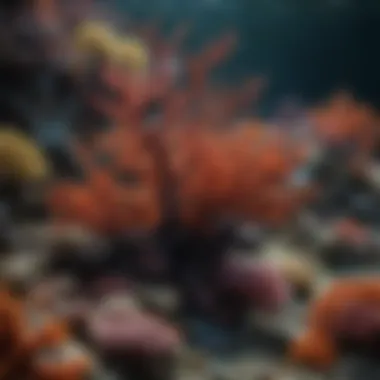
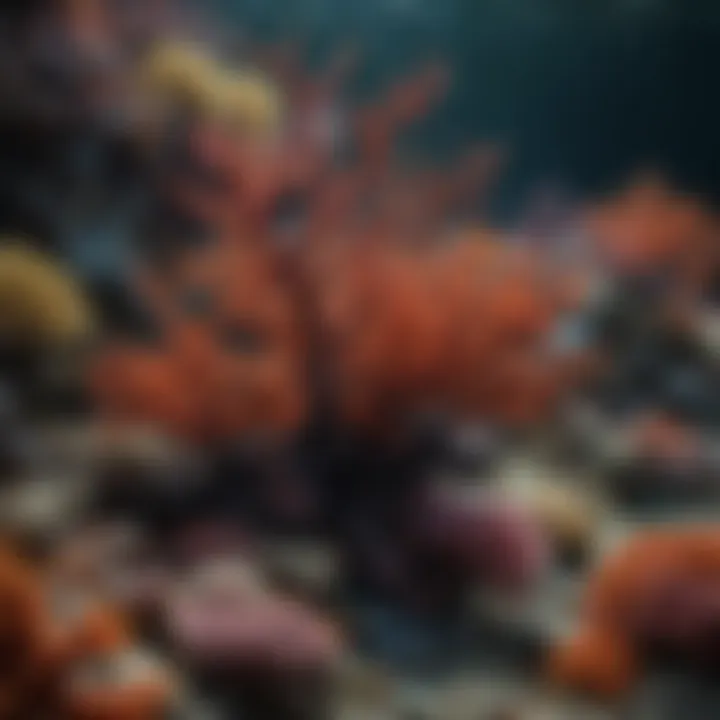
"Understanding the biology of black coral is not just academic; it's central to formulating effective conservation strategies in changing marine landscapes."
Habitat and Distribution of Black Coral
Understanding the habitat and distribution of black coral is vital in grasping its ecological role and the factors influencing its survival. It serves as the backbone of marine ecosystems, providing not only shelter but also playing a crucial part in the delicate balance of biodiversity. As we dive into the specific geographical presence and the environmental conditions it thrives in, we uncover how these factors both support and endanger black coral populations.
Geographical Presence
Global Distribution
Black coral predominantly flourishes in tropical and subtropical regions of the world’s oceans. Its expansive global distribution is a key aspect that influences marine biodiversity. Found at depths ranging from 30 to 3,000 meters, black coral grows in various underwater landscapes, including steep rocky slopes and the abyssal ocean floor.
One of the most fascinating characteristics of global distribution is the adaptability of black corals. These organisms can establish themselves in a myriad of marine environments, from the Caribbean Sea to the warm waters surrounding Australia. This adaptability is beneficial, as it allows black corals to occupy ecological niches that are otherwise not utilized by other marine organisms. However, the broad range also poses challenges regarding conservation efforts that need to be tailored to specific regions and conditions.
Specific Regions of Interest
When we zoom in on specific regions, places such as the Hawaiian Islands and the deep waters off the coast of the Bahamas emerge as vital habitats for black corals. These areas exhibit unique characteristics, such as nutrient-rich currents and relatively stable environmental conditions, providing a perfect environment for growth. The islands offer more than just ideal marine conditions; they also carry cultural significance, particularly in Hawaiian traditions, highlighting a blend of ecological value and human heritage.
While these regions offer advantages for black coral populations, they are not without their vulnerabilities. Increased human activity in these coastal areas, including tourism and fishing pressures, puts additional strain on their already delicate ecosystems. Understanding these dynamics helps illustrate the balancing act between ecological integrity and human influence.
Environmental Conditions
Deep-sea Ecosystems
Deep-sea ecosystems set the stage for black coral’s existence, characterized by low light and extreme pressures. These ecosystems are often overlooked yet hold an incredible diversity of life. The unique conditions of these environments, such as stable temperatures and diverse nutrient flows from water currents, are what allow black corals to thrive. It’s here, nestled in the deep and dark waters, that these organisms build their reefs, providing shelter for various marine species.
Additionally, deep-sea ecosystems contribute significantly to our understanding of marine life adaptations and resilience. By exploring how black corals manage to survive and flourish under such conditions, researchers gain insights into broader ecological patterns and relationships in marine biology.
Coral Reef Interactions
Black coral also plays a critical role in the interactions that occur within coral reef ecosystems. These interactions contribute to nutrient cycling and can even influence the population dynamics of various marine species. Coral reefs themselves are complex environments driven by the relationships between organisms, and black corals enhance this complexity by providing additional structural habitat, which other species rely on for survival.
In essence, the interdependence between black coral and its marine neighbors epitomizes the intricate web of life beneath the waves. By spotlighting these interactions, we can better appreciate the ecological web and recognize that the fate of black coral is closely tied to the health of the entire reef ecosystem.
"The interconnectedness of species within an ecosystem can often dictate the stability and resilience of that environment."
In exploring the habitat and distribution of black coral, it becomes clear that these organisms are not only vital for their immediate environments but are also integral to broader marine health. With pressures mounting from climate change and human activity, it’s imperative that we work towards their protection and conservation.
Ecological Importance of Black Coral
Black coral isn’t just a pretty face in the ocean; it plays a crucial role in maintaining the health of marine ecosystems. These fascinating creatures contribute significantly to biodiversity, providing crucial habitats for various marine species, and promoting nutrient cycling within their environments. Understanding the ecological importance of black coral aids in recognizing its intrinsic value beyond mere aesthetic appeal.
Role in Marine Biodiversity
Habitat Structure
Black coral forms intricate structures that act as underwater skyscrapers, creating lively habitats for a vast plethora of marine life. This habitat structure is vital because it offers shelter for juvenile fish and an array of other organisms. You could think of it as a bustling city, with different marine species residing in close quarters, each playing their part in the larger community.
One of the key characteristics of the habitat structure provided by black coral is its three-dimensional complexity. This unique feature ensures that various organisms find niches to thrive, significantly boosting local biodiversity. Coral gardens often serve as hotspots, attracting species that might not find suitable environments elsewhere.
The advantages inherent in such habitat complexity cannot be overstated. For instance, it helps sustain fisheries by providing spawning and nursery grounds for commercially important fish species. However, the disadvantage comes from the fragility of these structures; they are susceptible to human activities like trawling and pollution, which can devastate the habitats.
Nutrient Cycling
Nutrient cycling is another critical aspect linked to black coral. These organisms assist in the distribution of essential nutrients within their environments, helping to sustain the web of life around them. The key characteristic here is their ability, in conjunction with other marine life forms, to recycle organic matter, ensuring that nutrients are effectively utilized.
Black coral’s role in nutrient cycling is beneficial because it links various components of the marine ecosystem together, from microorganisms to large fish. When they shed their polyps, the resulting organic matter acts as food for a plethora of smaller organisms, contributing to a cycle of nutrient availability that fosters life.
Still, the downside lies in the sensitivity of this process to environmental changes. Factors like climate change and water quality can upset these cycles, leading to declines not only in black coral but the vast array of marine life that depends on their presence.
Interactions with Other Marine Species
Black coral doesn't exist in isolation; it interacts with numerous species, from predators to partners, forming a complex web of interactions that further underscore its ecological significance.
Predator-Prey Dynamics
In the dance of life within the ocean, black corals often find themselves caught in predator-prey dynamics. These relationships highlight the vital roles that each player has in the ocean ecosystem. For instance, certain fish species rely on black coral as a source of food, while dispatching waste materials that can be utilized by the coral itself, creating a mutual dependency.
This dynamic is beneficial because it sets up a balance; when predator populations are stable, they help maintain the health of coral populations by controlling herbivore numbers, which could otherwise overgraze and damage coral structures. The disadvantage, however, lies in how disruptive changes—like overfishing—can upset these dynamics, leading to imbalances that spell trouble for black coral environments.
Mutualistic Relationships
Black coral engages in unique mutualistic relationships with various marine species, creating partnerships that benefit both parties. For example, certain types of fish, such as cleaner wrasses, find refuge among black coral while providing cleaning services, removing parasites and dead tissue from the coral.
The key characteristic of these mutualistic relationships is that they enhance the resilience of both species, ensuring that black coral remains healthy while providing fish with a secure habitat. However, disturbances to either party—due to pollution or habitat destruction—can unravel these partnerships, revealing how fragile these connections can be, right as they contribute immensely to biodiversity and ecosystem vitality.
These dynamics illustrate the intricate connections within marine ecosystems, where the health of one species often hinges on the well-being of others.
In summary, black coral’s ecological importance is multifaceted. From being a critical habitat structure to playing a vital role in nutrient cycling, predator-prey dynamics, and mutualistic relationships, it is clear that the survival and health of these corals are pivotal to sustaining the vibrant tapestry of marine life.
Cultural and Economic Value of Black Coral
Black coral holds a significant place in both cultural and economic contexts. Its unique appearance and properties have made it a desired material across various domains, from artisan crafts to medicinal practices. Understanding the cultural heritage tied to black coral, alongside its economic implications, is crucial in appreciating its value and advocating for its protection.
Historical Uses in Artisan Crafts
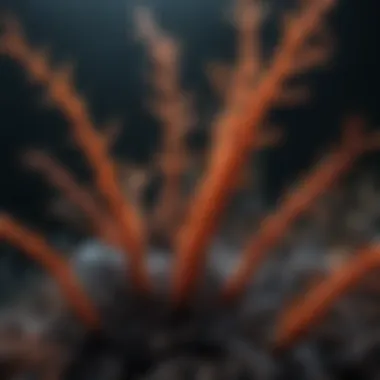
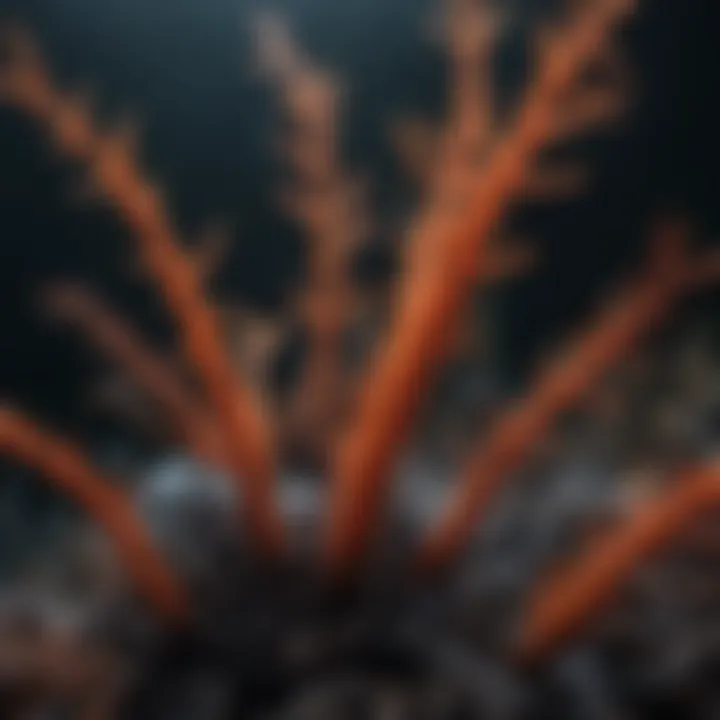
Historically, black coral has been revered in many cultures for its aesthetic qualities. Artisans have always been in search of materials that not only provide durability but also possess intrinsic beauty. The intricate carvings and polished items made from black coral tell stories of tradition and craftsmanship.
- Craftsmanship: Artisans utilize black coral in creating various decorative items, from jewelry to intricate sculptures. This level of craftsmanship represents a deep connection to cultural traditions.
- Symbolic Significance: In several cultures, items fashioned from black coral carry symbolic meanings. They are often associated with protection and are believed to ward off negative energies.
- Artisan Communities: The crafting of black coral has fostered communities of artisans, bolstering local economies and maintaining traditional practices.
The importance of these historical uses is not just in the physical items produced, but also in the continuation of cultural practices and heritage that these artisans uphold.
Contemporary Applications
In modern society, the applications of black coral have evolved but still hold on to their cultural roots. As we delve into its contemporary applications, we should look at two notable areas: Jewelry and Traditional Medicine.
Jewelry
Within the realm of jewelry, black coral has carved out a niche that appeals to the discerning tastes of collectors and enthusiasts alike. Its rich color and unique texture create eye-catching pieces.
- Popularity: Jewels crafted from black coral are sought after, often considered as statement pieces that fuse elegance with a touch of the exotic. The natural allure of black coral gives jewelry a unique character that synthetic materials simply can't replicate.
- Sustainability Concerns: Despite its popularity, the use of black coral in jewelry comes with its challenges. Overharvesting can lead to significant ecological damage. As demand rises, it becomes vital to source black coral responsibly, ensuring sustainable practices are in place.
The impact of black coral jewelry not only adds to individual aesthetic but also contributes to conversations around conservation efforts.
Traditional Medicine
Beyond aesthetic value, black coral has been utilized in traditional medicine for many centuries. Its unique properties are said to be beneficial in managing various conditions.
- Medicinal Uses: Some cultures have employed extracts from black coral in remedies addressing skin issues and joint pains. The elemental properties of this marine organism are believed to enhance healing processes, sparking interest in pharmacological applications.
- Research Interest: There's a growing body of research investigating the bioactive compounds sourced from black coral. While ancient practices have their place, modern scientific inquiry is beginning to uncover the potential these compounds may have.
However, the use of black coral in traditional medicine must tread carefully to avoid overexploitation. Balancing respect for traditional practices with the need for conservation is a challenge that needs to be met head-on.
"The cultural richness of black coral provides a bridge between heritage and modernity, showcasing the importance of sustainable practices for future generations."
In summary, the cultural and economic value of black coral is multi-faceted. From artisan crafts that uphold age-old traditions to contemporary applications like jewelry and traditional medicine, black coral continues to be an integral part of human culture and health. However, it is essential to navigate the complexities of these uses with a focus on sustainability to ensure that this beautiful marine organism can thrive for many more generations to come.
Threats to Black Coral Populations
Understanding the threats faced by black coral is paramount in grasping its significance in marine ecosystems. This section sheds light on the pressing factors contributing to declines in black coral populations, which not only diminishes biodiversity but also affects the overall health of marine environments. Key elements such as climate change, human activities, and pollution serve as primary stressors impacting these ancient organisms. Each of these threats interconnects in complex ways, influencing black coral survival and the resilience of the larger ecological framework.
Climate Change Impacts
Climate change presents numerous challenges to marine ecosystems, and black coral is no exception. The key characteristics of climate change—such as ocean acidification and temperature variability—play critical roles in the survival and health of black coral populations.
Ocean Acidification
Ocean acidification, arising from increased carbon dioxide absorption by oceans, alters the marine chemical landscape significantly. The water becomes more acidic, which can have detrimental effects on the calcium carbonate structures that black corals rely on for growth. - This process raises the concern that black coral may struggle to maintain its skeleton's integrity, crucial for its survival.
- Unique Feature: A notable aspect of ocean acidification is its gradual nature, which can lead to long-term, latent effects on coral health.
This subtle threat may not yield immediately observable outcomes but accumulates over time, potentially leading to mass mortality events among sensitive coral species. Given the unique growth patterns of black corals, which can live for centuries, the implications of acidification extend far into future generations.
Temperature Variability
Temperature variability involves fluctuations in sea temperature that can exceed the tolerable thresholds for black corals. - Such conditions can lead to thermal stress, resulting in bleaching phenomena similar to those observed in shallow-water coral species.
- Key Characteristic: Black corals thrive in relatively stable environments. When temperatures rise or fall abruptly, their physiological processes can be adversely affected.
The challenge posed by temperature variability lies in its unpredictability. As ocean temperatures fluctuate due to climate change, black coral's adaptive strategies could be overwhelmed, complicating resilience efforts. The unique habitats that these corals occupy are increasingly at risk, and this could jeopardize not just the corals themselves but also the diverse ecosystems that depend on them.
Human Activities
Human actions significantly contribute to the decline of black coral populations. The intertwining of these activities with natural threats compounds the challenges that black corals face.
Overfishing
Overfishing leads to the depletion of marine species that interact with black coral ecosystems. The loss of fish species can disrupt ecological balance, undermining nutrient cycling and habitat structure. - Additionally, overfishing can exacerbate issues related to predator-prey dynamics, particularly affecting species that rely on black corals for shelter and food sources.
- Key Characteristic: Its indirect consequences often go unnoticed; however, the repercussions ripple through the food web, intensifying the vulnerability of black corals.
Understanding overfishing's cumulative effects can help craft strategies to mitigate these indirect threats and promote a healthier marine environment where black corals can thrive.
Habitat Destruction
Habitat destruction is another urgent problem facing black corals. Activities such as coastal development, dredging, and destructive fishing practices disrupt the delicate environments where black corals flourish. - The removal of substrate and alteration of current flow can degrade the essential habitats crucial for their growth.
- Unique Feature: Once black coral habitats are disturbed, their recovery necessitates a lengthy process due to the slow growth rates of these organisms.
The permanence of habitat destruction highlights the need for sustainable practices and mindful regulations to protect these vital marine ecosystems.
Pollution
Pollution, encompassing a range of contaminants, from plastics to agricultural runoff, poses severe risks to black coral populations. The introduction of toxins can alter water quality, harm associated marine life, and lead to disease outbreaks among coral colonies. - Changes in nutrient levels can encourage harmful algal blooms, which further threaten black coral survival by blocking sunlight and smothering these organisms.
- Key Characteristic: Pollution often exacerbates existing stresses on black corals; it is not merely an isolated threat but rather a synergistic problem intertwined with climate change and human activity.
The intricate web of pollution's impact sheds light on how essential it is to implement effective waste management and to raise public awareness about protecting marine habitats.
"The health of one species often reflects the health of an entire ecosystem. Thus, protecting black coral means protecting a more extensive network of life across our oceans."
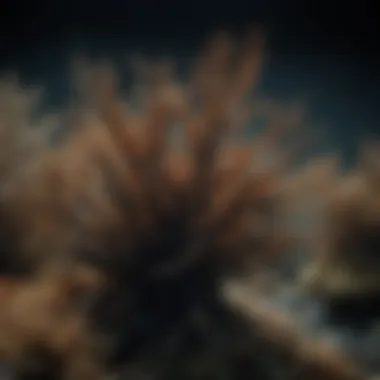

By illuminating the various threats that black corals face, we highlight the pressing need for greater conservation efforts. Understanding these threats can help galvanize action to protect these unique and ecologically important organisms.
Conservation Efforts for Black Coral
Preserving black coral is more than a mere environmental concern; it is a critical obligation towards maintaining marine biodiversity. Black coral serves as a habitat for numerous marine species and plays a significant role in ecosystem balance. Conservation efforts are essential to safeguard its survival amidst escalating threats like climate change and human intervention. These strategies are multifaceted, focusing on legislative measures, scientific research, community involvement, and restoration projects that ensure sustainable practices.
Legislative Framework
International Treaties
International treaties offer structured cooperation among nations to address the conservation of black coral. Agreements like the Convention on Biological Diversity (CBD) emphasize the preservation of marine environments. One significant characteristic of these treaties is their global scope, fostering collaboration on a large scale. Notably, they set binding commitments for member countries, compelling them to initiate domestic actions that benefit black coral populations. The distinctive feature of these agreements lies in their holistic approach, addressing not only coral but also the intricate web of life within the marine ecosystem.
However, these treaties face challenges, such as varying levels of commitment from countries. Some nations may lack the resources or political will to enact strong conservation policies, potentially undermining the overall goals. Despite these issues, international treaties are vital in creating a unified front to protect global marine biodiversity.
National Policies
National policies shape the on-the-ground application of conservation efforts for black coral. These frameworks usually include regulations that aim to limit damage from fishing, pollution, and coastal development. One defining attribute of national policies is their adaptability; they can be tailored to suit specific local conservation needs, making them crucial in addressing urgent threats to black coral habitats. Oftentimes, they are also put in place following international guidelines, thus ensuring a degree of synergy within global conservation efforts.
Nevertheless, national policies can be unevenly enforced, leading to gaps in protection. Some regions may not have robust monitoring systems in place, allowing illegal activities to persist. Despite these shortcomings, well-crafted national policies are indispensable tools in the conservation of black coral, providing targeted defenses against specific threats.
Research and Monitoring Initiatives
Scientific Studies
Scientific studies play a pivotal role in the conservation of black coral. Research is essential for understanding the ecological dynamics of these organisms, particularly their responses to environmental stressors. A key characteristic of scientific studies is their reliance on empirical data to shape policy decisions and conservation strategies. They offer insights into reproductive patterns, health status, and the impacts of climate change, which are crucial for developing effective conservation measures.
A unique feature of these studies is their collaborative nature; they often involve institutions across various disciplines and geographic areas. The advantage is a comprehensive understanding of the issues at hand, informed by diverse expertise. However, the downside can be the time it takes to conduct thorough research; results may lag behind immediate conservation needs, creating potential gaps in knowledge that must be urgently addressed.
Community Involvement
Community involvement is another cornerstone in the successful conservation of black coral. Local communities often hold invaluable traditional knowledge and a vested interest in the health of marine ecosystems. This characteristic makes community engagement essential in driving conservation efforts at the grassroots level. By integrating local perspectives with scientific insights, more effective and culturally relevant solutions can be developed.
One unique feature of community involvement is the potential for citizen science initiatives, empowering individuals to contribute to monitoring efforts. This not only enhances data collection but fosters a sense of ownership over local marine environments. However, mobilizing communities requires resources and effective communication strategies. Without proper support, initiatives may falter, despite the inherent motivation and concern from local residents.
Restoration and Rehabilitation Strategies
Translocation Projects
Translocation projects involve relocating black coral to safer habitats in a bid to enhance their chances of survival. These initiatives can serve as an immediate response to threats such as habitat degradation or climate change impacts. The attractive feature of translocation is its potential for rapid intervention; it can mitigate the effects of localized disturbances on coral populations. Additionally, successful translocation can create vital breeding populations in areas less affected by adverse conditions.
However, these projects come with challenges. Relocation success heavily depends on choosing the right recipient site, requiring a thorough understanding of ecosystem dynamics. Moreover, there remains uncertainty around the long-term viability of translocated populations, making this a complex strategy with both possibilities and pitfalls.
Aquaculture
Aquaculture offers a promising avenue for the sustainable management of black coral. By cultivating coral in controlled environments, we can both replenish natural populations and supply the demand for coral in the ornamental trade. An important aspect of aquaculture is its ability to create a sustainable source of black coral, reducing pressure on wild populations.
The unique feature of aquaculture is the potential to enhance genetic diversity by cultivating multiple strains. While this can be a significant advantage, it also raises challenges regarding the compatibility of farmed corals with wild environments. Additionally, setting up aquaculture ventures requires initial investments and expertise that may not be widely available, posing limits on its broader application.
Through combined efforts in legislation, scientific research, community action, and restoration initiatives, we can champion the preservation of black coral for future generations, ensuring its continued presence in our oceans.
Future Directions in Black Coral Research
Research into black coral is moving into exciting new territories, and understanding these future directions is crucial for anyone interested in marine biology and conservation. As environmental changes increasingly threaten marine ecosystems, innovative research techniques become more pivotal. New methodologies not only clarify our understanding of black coral's biological and ecological roles but also fuel conservation efforts. Furthermore, increased global cooperation in marine research amplifies the impact of findings, ensuring actionable strategies can be put into practice.
Innovative Research Techniques
Genetic Studies
Genetic studies provide a lens into the complex life of black coral, laying the groundwork for various conservation strategies. By analyzing the DNA of black coral species, researchers can discern genetic diversity, which is essential for the resilience of populations against environmental stressors. This characteristic makes genetic studies a powerful tool, as understanding genetic variations helps in identifying which populations are more likely to survive climate changes.
One unique feature of genetic studies is their ability to reveal relationships and kinship among different black coral populations. Through this lens, scientists can identify breeding patterns and connectivity between habitats. However, these studies can be resource-intensive and require access to advanced technologies and techniques, which may not always be available to all research teams.
Remote Sensing
Remote sensing technology presents another captivating avenue for research. It allows scientists to gather data about black coral habitats without intrusive marine surveys, which can be damaging. This approach uses satellite imagery and aerial photography to monitor environmental conditions and changes over vast areas, making it a practical choice in today’s fast-paced world of marine research.
The key characteristic of remote sensing lies in its ability to efficiently collect data over large marine areas. This saves time and resources while providing reliable information on habitat health. However, it comes with challenges, such as the need for accurate interpretation of data and a potential loss of local specificity.
Global Cooperation and Knowledge Sharing
In our interconnected world, the challenges facing black coral populations and their ecosystems cannot be met by isolated efforts. Collaborative global initiatives enhance the effectiveness of research and conservation strategies. By pooling resources, expertise, and data, countries can launch joint research projects that yield comprehensive insights into black coral biology and ecology.
Moreover, knowledge sharing fosters a better understanding of how different regions approach black coral conservation. For instance, nations with successful black coral management strategies can serve as models for others, creating a network of shared best practices. By encouraging participatory approaches in research, local communities can contribute valuable traditional knowledge that complements scientific data.
Overall, a robust focus on the future directions in black coral research opens the door to both scientific advancements and stronger conservation efforts, ensuring these remarkable organisms remain a vibrant part of our marine environments.
Epilogue
Summarizing Key Points
- Biological Characteristics: Black coral is characterized by its distinct skeletal structure, polyps, and reproductive strategies, showcasing unique adaptations to its deep-sea habitat.
- Ecological Importance: It plays a pivotal role in marine biodiversity and nutrient cycling, offering critical habitats for a myriad of marine life.
- Cultural and Economic Value: Historically significant in crafts and today valued in jewelry and traditional medicine, black coral supports local economies.
- Pressing Threats: Climate change, overfishing, and pollution pose substantial risks to black coral populations, demanding immediate attention.
- Conservation Efforts: Legislative frameworks, research initiatives, and community involvement are crucial elements in protecting black coral.
The Path Forward for Black Coral Conservation
For the future of black coral conservation, it is crucial to foster a multifaceted approach that encompasses scientific research, community awareness, and stronger policy frameworks. Promoting cooperation at various levels can lead to more robust protective measures. Here are some strategies to consider:
- Enhanced Research Initiatives: Investing in genetic studies and remote sensing technologies can provide deeper insights into black coral's biology and distribution.
- Global Collaboration: Facilitating knowledge sharing across countries can optimize conservation strategies and empower local communities.
- Public Awareness Campaigns: Educational efforts aimed at the public and stakeholders can galvanize support for conservation initiatives.
"The health of our oceans reflects the health of our planet, and protecting black coral is a crucial piece of the puzzle in ensuring marine ecosystems thrive."
In these ways, we can create a sustainable future for black coral and contribute to the resilience of marine ecosystems globally.



